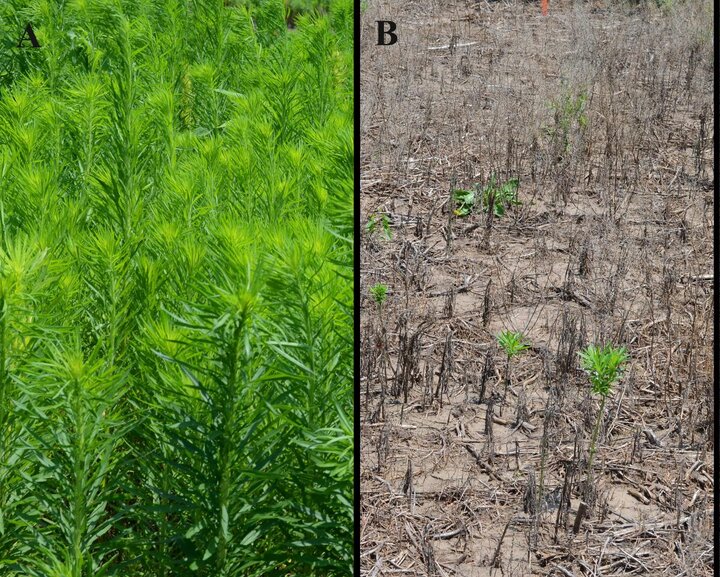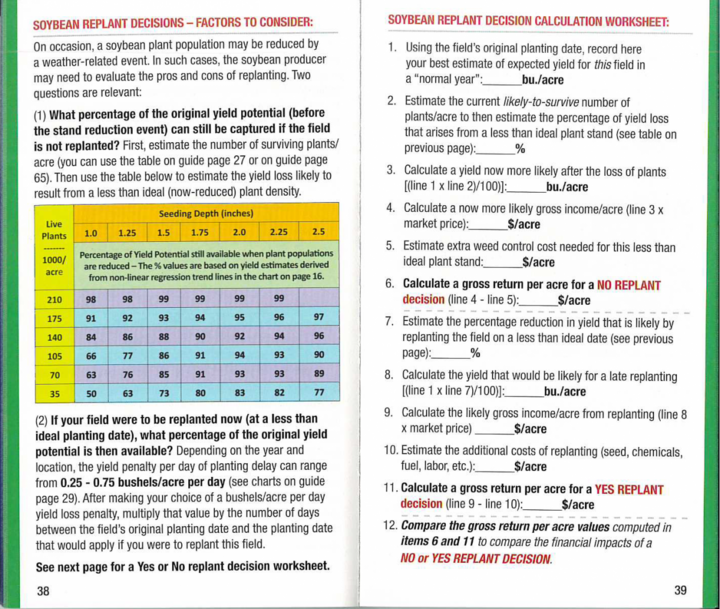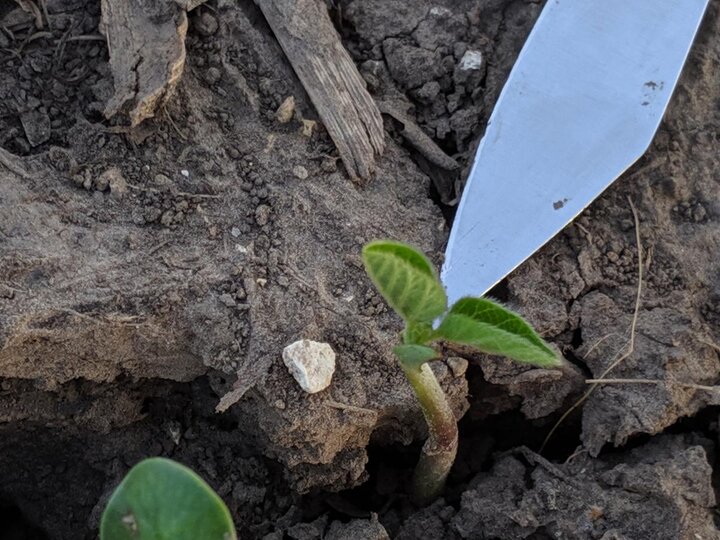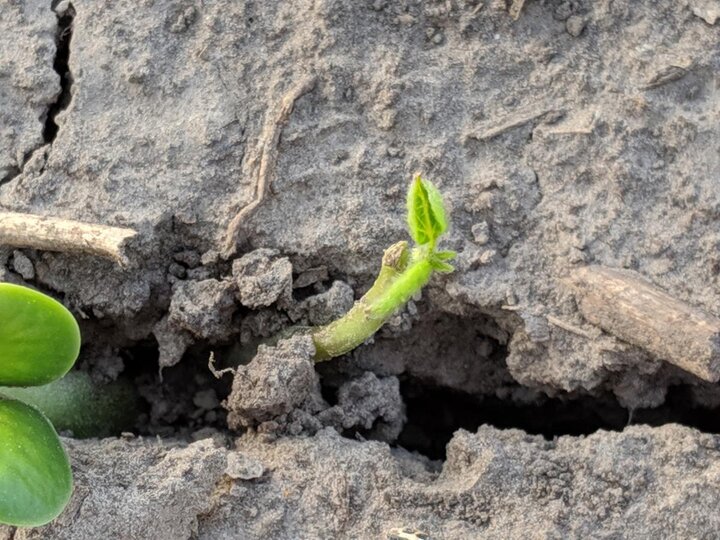Crusting in soybean (Figure 1) has been an issue at different points this entire season with several calls coming in this week from growers with non-irrigated fields.
Key Points
- Management options to help alleviate crusting are irrigation, if possible, rotary hoeing, or even running the planter shallow back across field.
- A general guideline is to leave a field alone if plant populations are greater than 50,000 plants per acre, the stand is uniform, and the field can be kept weed free.
- If you consider replanting, consider leaving some check strips and/or consider an on-farm research study.
- Flag a few plants where cotyledons have been stripped from the main stem to observe any regrowth.
Options to Alleviate Crusting
When faced with crusted soils, there are some management options to help plants that are struggling to emerge. For those with center pivot irrigation, running the irrigation system is the easiest option. The amount of water applied will need to be monitored to ensure that wetting is sufficient to reduce soil hardness.
For non-irrigated fields, options are limited to shallow tillage to attempt to physically break up the crusted top layer. Timing is an issue as one really needs to start running before any beans start emerging or shortly after to get the best benefit. If available, using a rotary hoe is an option. Some stand loss to already emerged plants is possible. Make sure to adjust the machine to only breakup enough soil to allow the plants to emerge. If a rotary hoe is not available, we have also heard of farmers running the planter back over the field with the depth set as shallowly as possible to allow either the disk openers or even the closing wheels of the planter to break the crust. As with a rotary hoe, this method may cause some damage to emerged plants.

-
Figure 2: A healthy soybean seedling that emerged with a partial cotyledon.
-
Figure 3: New growth occurring from where the cotyledon originally occurred on this plant. It’s unclear at this point if the main stem tip was lost or if new growth will be observed from it in the future.
-

Figure 4. Seedlings below the crust. For this photo, I removed the crust and opened the cotyledons to expose the first leaves. If the cotyledons are stripped when emerging through the crust and the growing point has moved above the cotyledons (epicotyl), then there’s an opportunity for the seeding to survive in spite of losing the cotyledons. This is shown in Figure 5 with the plumule emerging from the epicotyl.
-
Figure 5: Plumule emerging from the epicotyl on a seedling that had cotyledons stripped from crusting during emergence.

Research with Low Populations
Soybeans greatly compensate for reduced populations by increasing branching. Nebraska On-Farm Research from eastern Nebraska and western Nebraska for 12 years of combined data showed only a 1.3 bu/ac yield increase when seeding 180,000 soybean seeds/acre compared to 90,000 seeds/acre in 15-inch or 30-inch rows. (No studies were in sandy soils). Average final plant stands became 154,924 vs. 83,067 plants per acre respectively. Specific examples with lower final plant stands follow:
- A non-irrigated field in Nuckolls County in 2006 was hailed at the cotyledon stage, so planted populations of 100K, 130K, and 160K became average actual stands of 74,417; 89,417; and 97,917 plants per acre with a 4 bu/ac yield difference between highest and lowest plant populations. The average yield in the field was 40 bu/ac.
- An irrigated field in Hamilton County in 2010 showed a 3 bu/ac yield difference between planted stands of 80K versus 120K seeds/acre. Final plant stands weren’t taken.
- A York County irrigated field in 2018 comparing 90K, 120K, and 150K became final plant stands of 60,875, 88,125, and 121,750 plants/acre with yields of 93, 94, and 97 bu/ac respectively.
As you assess plant stands, keep in mind that a gap in one plant row will be compensated by plants in the adjacent flanking rows. They will form extra branches to take advantage of the sunlight. Thus single-row gaps may not be as yield-reducing as you might think, especially in narrower row spacings.
Replant Considerations

Any anticipated yield loss from the reduced stand must be balanced against the anticipated yield loss from replanting after the optimum planting date. Nebraska research has consistently shown the benefit of early soybean planting for higher yields. This is mainly due to node accrual on the main stem which allows for an increased potential for pods and seeds compared to planting later. Thus, replanting may not out-yield the original planted stand even at lower plant populations. Thorough scouting on foot or ATV and taking numerous counts may help pinpoint certain areas within a field to spot in/replant a portion of the field instead of the entire field.
Weed control is another factor, depending on the time of year, for soybean replant consideration. Leaving a poor stand may result in poor weed control or increased herbicide costs. Replanting may entail additional costs for seed, tillage, and replanting in addition to the potential yield penalty imposed by a later-than-normal planting date. We would recommend a seed treatment when replanting soybean.
When in doubt, consider testing this for yourself! Leave checks in your field that can be compared to where you replant. You can also consider this as an on-farm research study by contacting your local Extension Educator like a grower in Platte County did in 2014. He originally planted 145,000 seeds/acre on May 10 no-till into heavy corn residue. With a plant stand of 75,000 plants per acre, he chose to replant soybeans in strips across the field. He left the original stand and planted an additional 145,000 seeds/acre. Final yields were 58 and 57 bu/ac for the original and replanted stand, respectively.
For more information, see the “Soybean Replant Decision Calculation Worksheet” on page 39 in the Nebraska Soybean & Corn Pocket Field Guide.
Soybean Physiology
Don’t automatically write off seedlings where cotyledons were stripped off when pulling through crusted ground. If the growing point has moved up the main stem above the cotyledons and the epicotyl is not damaged, you may see a plumule form at the top of the stripped stem. The plumule is the seedling stem tip and its undeveloped leaves above the cotyledonary node. Without the cotyledons to serve as a carbon and nitrogen source, development of new seedlings with small leaflets will be slow and yield may be reduced by 5-10%. If one undamaged cotyledon remains, the delay and yield loss is usually minimal.
For more information on reduced soybean planting rates, see the CropWatch story Soybean Seeding Rates. If you consider replanting, please see Strategies with Delayed Soybean Planting for more information on soybean planting considerations this time of year.
//


